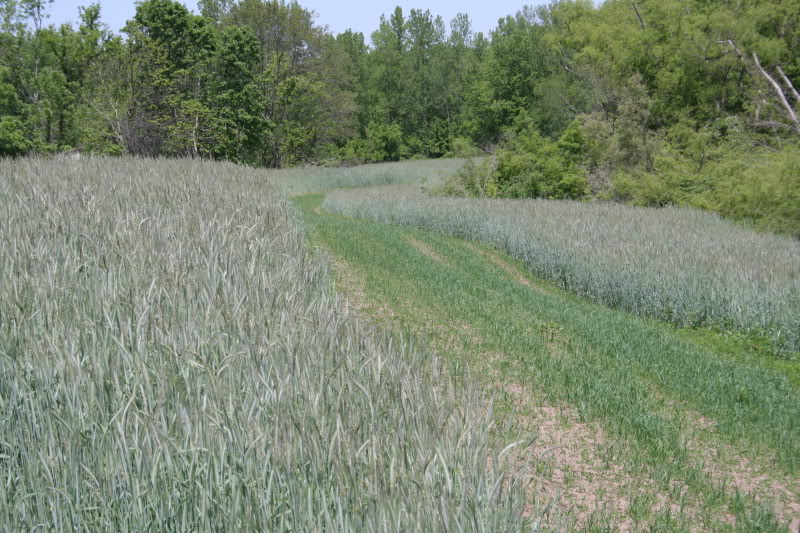Thanks for the great pics Mike! :way:
May 17th, 2012
There are several key issues involving feeding areas that we want to avoid...
1) Avoid having a "dirt plot"
2) Avoid having only one crop in your feeding area
3) Avoid planting the same crop in the same place two years in a row
We can easily avoid any and all of those problems by having multiple crops in each feeding area, even a 20X60 garden sized plot can easily be divided into 3 strips each containing a different crop and then rotating those crops. No crop can by itself provide a source of year around food but combining the right crops this can be accomplished easily.
At seasons end, brassicas are kaput and when spring comes the area is a "dirt plot"...bad for the soil and bad for whitetails, so one way to solve that problem is to plant the spent brassica strip to oats and annual clovers. I like to use Jerry oats and a mix of crimson and berseem clovers but any oats including feed grade oats will work and there are other cloves such as arrowleaf depending on what area of the country you live in.
Winter rye kept deer fed all winter and into early spring but then it quickly matures and becomes unpalatable to deer, there is however lush red and white clover growing beneath the tall rye. Last year the center strip was brassicas, now it is lush tender oats and annual clovers that are growing rapidly.
I clipped the rye off recently exposing the fall planted clovers
but deer are never for a moment lacking something eat and have beaten paths coming to this feeding area
I usually plant 50#'s of oats per acre as a cover and food source but rates can be increased to some extent and here I doubled the rate on side for a test example
Note that the Jerry oats ( a common oat in the Midwest planted by farmers to harvest...oats!) are heavily grazed
The crimson and berseem clovers are growing quickly...and it is for this reason i prefer annuals for a quick spring cover crop, white and red clover grows to slowly during establishment so I plant those in the fall.
The annual clovers will provide a lush high protein source of food and...fix nitrogen that can be used by the rye mix that will follow this planting in late August.
The strip plots are set for awhile now...the far right strip was planted to white clover last August with the rye and will remain in perennial white clover for 3-5 years. The center strip that was brassicas, is now oats and annual clovers, will be planted to the rye combo in very late August. The far left strip was rye, oats, peas, radish and red clover last fall....now after clipping the rye only the red clover remains and this strip will be rotated to brassicas in July.

Using the strip or block planting of multiple crops within each feeding area helps us achieve our goals of attracting and holding whitetails on our property year around. Planting a single crop of soybeans or brassicas does...not! The combination of crops listed below and shown in the pictures above will adapt deer to feeding here year around and that in turn makes them very predictable and easy to harvest. I would add that at no time have we used herbicides (other then initial gly application to kill sod) in these feeding areas and over time the need for synthetic fertilizers will diminish markedly.
Lower your habitat expenses and increase your success rate at the same time by putting the following crop rotations into use on your farm.... :way:
Plant ALL in one plot in strips or blocks
Alice, KopuII, Durana (or comparable) white clovers 10% of plot...plant with the rye mix below and soil test for needed P&K/lime requirements. Lacking a soil test I use 400#'s of 6-28-28 and 500#'s of pel lime in my area.
Brassicas in 45% of plot
Purple Top Turnips 3#
Dwarf Essex Rape 2#
GroundHog Forage radish 5#
Plant in mid to late July in most midwest states, or 60-90 days before your first killing frost. Use 200#'s of 46-0-0 urea, 400#'s of 6-28-28 (or comparable such as 400#'s triple 19 ) Add lime per soil test. Follow the dead brassicas with 50#'s oats and 15-20#'s berseem and/or crimson clover in mid spring and no fertilizer is necessary at that time.
Cereal Grain combo in 45% of plot
Winter rye 50-80#'s per acre (56#'s = a bushel)
Spring oats 80-120#'s per acre (32#'s = a bushel)
Austrian Winter Peas or 4010/6040 Forage peas 20-80#'s per acre
Red Clover 8-12#'s per acre or white clover at 6#'s per acre
Groundhog Forage Radish 5#'s per acre
Plant in late August to early September, if following well fertilized brassicas only 100-200#'s of urea may be needed but first time plantings may need to be fertilized and limed as the noted for the brassicas.
Rotate the brassicas and rye combo each year
 acer Hybrid Brassica is a hybrid cross between a forage turnip and a forage rape.
acer Hybrid Brassica is a hybrid cross between a forage turnip and a forage rape. 













